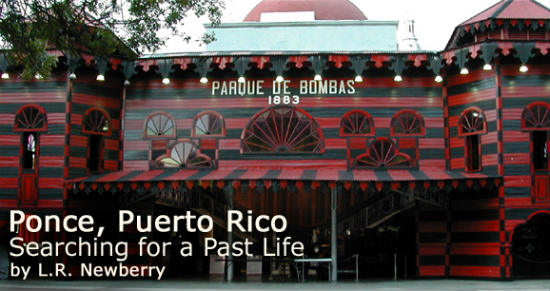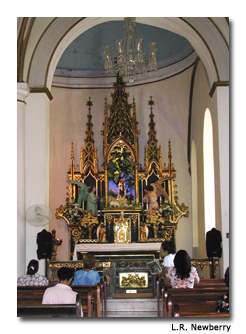

My stomach leapt as the compact rental car climbed higher along a road that would have been wide enough had it been a one-lane street. It wasn’t. There were no guardrails in most spots, and in others rickety posts supported wires that looked as if they would snap upon impact.
I stared in disbelief at a pair of preteens riding their bicycles back and forth on a 20 foot-(6 meters)-long stretch of flat road. I reflected on how brave a child would have to be to learn to ride a bike up there, high in the Cordillera Central mountains outside Ponce, Puerto Rico.
“I can’t believe we found this!” my father exclaimed. “The last time I was up here I was 6 years old. I was terrified!” I could see why. Dad had been describing the horrors of this road all my life, and I had assumed the sharpness of the curves and steepness of the hills had been magnified in the retelling over the years. It was every bit as bad as he remembered.
We had taken a wrong turn and wound up on this road twisting into the mountains, but even after we realized we were going the wrong way we continued. Dad had this maniacal grin on his face and I recognized the telltale signs of a man in the grip of a challenge.
I put on a brave face and attempted to admire the lush island greenery, every so often letting out a squeal or gasp as the road dropped suddenly or made a hairpin turn.
I finally had enough when the road headed straight up in the air — or so it seemed. I could hear our little car’s engine straining and I pictured it rolling backward down the hill and off the side of the mountain, arcing through the air like the final image in an action movie chase scene.
I insisted my father turn around in the next somewhat flat driveway that we found. We retraced our path back to the highway, with Dad grumbling that he could have made it to the top. Throughout the entire ride my 7-year-old and 4-year-old sat calmly in the back, playing games and looking up occasionally when I urged them to enjoy the scenery.
My father was excited to be returning to Ponce, the city of his birth, for five entire days. It was the longest he’d spent there since his family had moved to New York City over 50 years before. I was happy my children would be connecting to their grandfather and I’d be experiencing firsthand a place I’d heard about since I was a girl.
The night we arrived we took a stroll around Ponce’s plaza, the heart of the city today just as it was when my father was a child. Dad marveled at how little it had changed and pointed out the shoe store where he’d gotten his first pair of school shoes. We stopped for pictures at the brightly colored Parque de Bombas, a building that once served as the town’s firehouse but is now a tourist attraction.
We continued around the square to Catedral Nuestra Señora de la Guadalupe, checked out the Mass schedule for the next day, then continued on to the magnificent water fountain at the center of the square. The fountain is flanked by lions in honor of Ponce de León, Ponce’s namesake and the first governor of Puerto Rico. We ended up across the street from the plaza at a tiny ice cream shop serving exotic flavors such as guava and tamarind in addition to the predictable chocolate.
The next morning, Dad, the kids and I walked to the cathedral for Mass, just as my father had every Sunday of his youth. The four of us filed in, our shoes tapping on the black and white marble floor, and slid into an empty pew. The cathedral reminded me of an elderly woman who is still so pretty that you know she must have been extraordinarily beautiful in her youth.
The paint was peeling in places and many of the statues and ornaments were covered in plastic while repairs were made on one side of the church, but we could guess at the magnificence of the hidden statues from the ones that remained visible.
Later, we headed to the Castillo Serrallés, a mansion built high on a hill in the 1930s by Juan Eugenio Serrallés, son of Juan Serrallés.
The elder was the founder of Serrallés Distillers, maker of the famous Don Q rum. From the house one can see all of Ponce spreading out to the sea and I imagined that Serrallés must have felt like royalty with his kingdom before him.
My grandfather and great-grandfather both worked at the Serrallés family’s Mercedita sugar refinery, and my father was thrilled at the chance to tour the mansion that had once belonged to his grandpa’s boss. We watched a short film about the Serrallés family’s rum and sugar processing operations, then toured the mansion, which still contains much of the original artwork and furnishings.
One section of the home was devoted to the family businesses, with models, tools and black-and-white pictures on the walls. Dad was delighted to find his grandfather gazing coolly back at him from a photograph of supervisors and managers of the sugar plant.
I think of him posing for that picture with his friends from the other departments, young and handsome, never guessing that one day far in the future his great-great grandchildren would be excited over it.
The next day was our mountain road adventure. After winding our way back down to flat ground and broad avenues, we located our original destination: the Tibes Indigenous Ceremonial Center. The center had been a meeting place for the island’s indigenous people as far back as 25 B.C. It was abandoned and forgotten for hundreds of years until a hurricane ripped across the region in 1975, causing floods that unearthed native carvings, pottery and human bones.
Today, visitors can wander through the small museum near the entrance to view artifacts that have been discovered here before touring the site. Tours are given in English and Spanish and begin with a short film.
Visitors are then led into the lush, peaceful ceremonial grounds, where they can see how the natives once lived and played. Typical dwellings of the past have been reconstructed on the site, though our colorful guide Sal informed us that Tibes was more of a community meeting spot for the area’s tribes than a village.
A garden is planted with the crops natives cultivated, and trees and plants that grew naturally in the area are everywhere. The tour ends at the courts where the tribe members played ball games. Archaeological digs are still conducted at Tibes. According to our guide another body had been found just three weeks before our arrival, bringing the count into the upper 180s.
We visited the city’s art museum, Museo de Arte de Ponce, a modern building on the south side of the city, near the University of Puerto Rico – Ponce. I had underestimated the museum and was pleasantly surprised by the scope of its collection, which I learned is the largest in the Caribbean.
I stumbled upon a work by one of my favorite artists, an image that I had seen in countless calendars and poster catalogs: Frederick Lord Leighton’s “Flaming June.” The museum picked it up for $6,000 in the ‘60s when Victorian art was considered unfashionable. The sensuous image of a sleeping woman in a filmy orange gown is considered by many to be Leighton’s finest work.
My father wanted to hunt down his childhood home on Calle Arena and we drove through the narrow, largely unmarked streets searching among the Easter-egg-colored homes. Many of the houses have fallen into disrepair. When we found the remains of Dad’s grade school, the roof gone, walls crumbling and tree branches reaching out of windows, he began wondering whether his house would still be standing.

Finally, we rounded a corner and there it was — a pretty pink house well kept by current owners and much smaller than Dad remembered.
He reminisced about how, as a preschooler, he had once stood on the porch during Carneval festivities, which occur every year before Lent. A vejigante, or merrymaker dressed in a demonic mask and costume, had climbed up the railing to scare him and his mother had chased the guy off with a broom.
That night there was a parade around the plaza, and we walked to the corner to watch the high school bands and fire engines pass. Suddenly, a man in a brightly colored satin jumpsuit and scary mask with half a dozen horns sprouting from it spotted us from halfway down the block and ran toward us, waving his arms.
My 4-year-old daughter jumped behind me, clinging to the back of my legs, as my Dad shouted with delight, “It’s a vejigante!” When he reached us, the vejigante gave each of the kids a piece of candy. I smiled as my brave kids accepted the banana toffee.
In years to come, when my father shares his childhood stories with his grandchildren, they’ll be able to picture the drop from the tiny mountain road, feel the fear as the vejigante bears down on the boy standing on the porch of the little pink house and remember the magnificence of the house on the hill, looking out over the city.
If You Go
Welcome to Puerto Rico
www.welcome.topuertorico.org
Let’s Go to Ponce
www.letsgotoponce.com
L.R. Newberry’s family, travel, reading and writing are her passions. Visiting a fun new spot with the hubby and kids in tow and a light novel and her travel journal for down time is her idea of bliss.
- Life of a Champion: Exploring the Muhammad Ali Center in Louisville - April 19, 2024
- What It’s Like to Live as an Expat: Lake Chapala, Mexico - April 18, 2024
- Top 5 Spots for Stargazing in North Carolina - April 17, 2024
